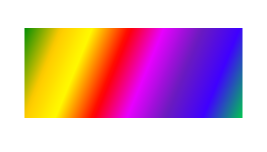Working with Gradient in XPS file | Python
A gradient is a gradual transition between two or more colors or shades. In visual arts, graphics, and design, gradients are often used to create smooth transitions from one color to another, adding depth, dimension, and visual interest to an object or image. Gradients can vary in complexity, from simple two-color gradients to more intricate blends involving multiple colors or even transparency levels.
Here you will find out how to add different types of gradients to XPS files in Python.
Add Gradient in XPS Document
Add Horizontal Gradient
Aspose.Page for Python via .NET provides the XpsGradientBrush Class, created to incorporate gradients into XPS documents. To achieve this, you must specify XpsGradientStop and add XpsPath to the object of the XpsDocument class. The following code snippet demonstrates the complete functionality for adding a horizontal gradient to an XPS document:
The result

1from aspose.page.xps import *
2from aspose.page.xps.xpsmodel import *
3import aspose.pydrawing
4from util import Util
5###############################################
6###### Class and Method declaration here ######
7###############################################
8
9# The path to the documents directory.
10data_dir = Util.get_data_dir_working_with_gradient()
11# Create a new XPS Document
12doc = XpsDocument()
13# Initialize a List of XpsGradentStop
14stops = []
15stops.append(doc.create_gradient_stop(doc.create_color(255, 244, 253, 225), 0.0673828))
16stops.append(doc.create_gradient_stop(doc.create_color(255, 251, 240, 23), 0.314453))
17stops.append(doc.create_gradient_stop(doc.create_color(255, 252, 209, 0), 0.482422))
18stops.append(doc.create_gradient_stop(doc.create_color(255, 241, 254, 161), 0.634766))
19stops.append(doc.create_gradient_stop(doc.create_color(255, 53, 253, 255), 0.915039))
20stops.append(doc.create_gradient_stop(doc.create_color(255, 12, 91, 248), 1))
21# Create a new path by defining geometery in an abbreviation form
22path = doc.add_path(doc.create_path_geometry("M 10,210 L 228,210 228,300 10,300"))
23path.render_transform = doc.create_matrix(1, 0, 0, 1, 20, 70)
24gradient: XpsLinearGradientBrush = doc.create_linear_gradient_brush(aspose.pydrawing.PointF(10, 0), aspose.pydrawing.PointF(228, 0))
25path.fill = gradient
26gradient.gradient_stops.extend(stops)
27# Save the resultant XPS document
28doc.save(data_dir + "AddHorizontalGradient_outXPS.xps")Add Vertical Gradient
Aspose.Page for Python via .NET includes the XpsGradientBrush Class, for incorporating gradients into XPS documents. To accomplish this, you must specify XpsGradientStop and add XpsPath to the object of XpsDocument class. The following code snippet demonstrates the complete functionality for adding a vertical gradient to an XPS document:
The result

1from aspose.page.xps import *
2from aspose.page.xps.xpsmodel import *
3import aspose.pydrawing
4from util import Util
5###############################################
6###### Class and Method declaration here ######
7###############################################
8
9# The path to the documents directory.
10data_dir = Util.get_data_dir_working_with_gradient()
11# Create a new XPS Document
12doc = XpsDocument()
13# Initialize a List of XpsGradentStop
14stops = []
15stops.append(doc.create_gradient_stop(doc.create_color(253, 255, 12, 0), 0))
16stops.append(doc.create_gradient_stop(doc.create_color(252, 255, 154, 0), 0.359375))
17stops.append(doc.create_gradient_stop(doc.create_color(252, 255, 56, 0), 0.424805))
18stops.append(doc.create_gradient_stop(doc.create_color(253, 255, 229, 0), 0.879883))
19stops.append(doc.create_gradient_stop(doc.create_color(252, 255, 255, 234), 1))
20# Create a new path by defining geometery in an abbreviation form
21path = doc.add_path(doc.create_path_geometry("M 10,110 L 228,110 228,200 10,200"))
22path.render_transform = doc.create_matrix(1, 0, 0, 1, 20, 70)
23gradient: XpsLinearGradientBrush = doc.create_linear_gradient_brush(aspose.pydrawing.PointF(10, 110), aspose.pydrawing.PointF(10, 200))
24path.fill = gradient
25gradient.gradient_stops.extend(stops)
26# Save the resultant XPS document
27doc.save(data_dir + "AddVerticalGradient_outXPS.xps")Add Diagonal Gradient
The next code snippet shows complete functionality of how to add a linear gradient on an XPS document:
1# The path to the documents directory.
2data_dir = Util.get_data_dir_working_with_gradient()
3# Create a new XPS Document
4doc = XpsDocument()
5# Initialize a List of XpsGradentStop
6stops = []
7# Add Colors to Gradient
8stops.append(doc.create_gradient_stop(doc.create_color(0, 142, 4), 0))
9stops.append(doc.create_gradient_stop(doc.create_color(255, 202, 0), 0.144531))
10stops.append(doc.create_gradient_stop(doc.create_color(255, 250, 0), 0.264648))
11stops.append(doc.create_gradient_stop(doc.create_color(255, 0, 0), 0.414063))
12stops.append(doc.create_gradient_stop(doc.create_color(233, 0, 255), 0.544922))
13stops.append(doc.create_gradient_stop(doc.create_color(107, 27, 190), 0.694336))
14stops.append(doc.create_gradient_stop(doc.create_color(63, 0, 255), 0.844727))
15stops.append(doc.create_gradient_stop(doc.create_color(0, 199, 80), 1))
16# Create a new path by defining geometery in an abbreviation form
17path = doc.add_path(doc.create_path_geometry("M 10,10 L 228,10 228,100 10,100"))
18path.render_transform = doc.create_matrix(1, 0, 0, 1, 20, 70)
19gradient: XpsLinearGradientBrush = doc.create_linear_gradient_brush(aspose.pydrawing.PointF(10, 10), aspose.pydrawing.PointF(228, 100))
20path.fill = gradient
21gradient.gradient_stops.extend(stops)
22# Save the resultant XPS document
23doc.save(data_dir + "AddDiagonalGradient_outXPS.xps")The result

You can download examples and data files from GitHub.